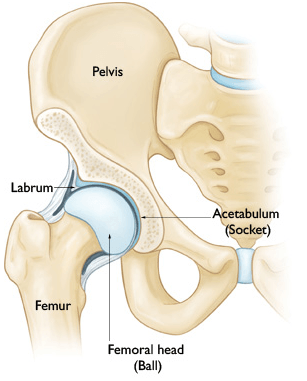Labral Tear
What is the labrum?

The hip joint is a ball-and-socket joint consisting of the femoral head (ball) and acetabulum (socket). Both sides of the joint are lined with smooth articular cartilage that creates a low-friction bearing surface. The labrum consists of another type of cartilage – fibrocartilage – and forms a ring around the rim of the acetabulum. The labrum is important for the health, lubrication, and stability of the hip joint.
Why does the labrum tear?
While the labrum can tear due to a distinct traumatic injury such as a fall, it is also common for the labrum to become injured due to repetitive stress. This is often the case in people with bone structure that causes the labrum to see excessive stress, as occurs in people with femoroacetabular impingement (FAI).
What are the symptoms of a labral tear?
Individuals with labral tears generally experience pain in the hip and groin region. Painful clicking or popping sensations often occur as well. This groin pain often results in delayed diagnosis, because many people do not realize that hip joint problems such as labral tears result in groin pain.
How is a labral tear diagnosed?
Dr. Driscoll will discuss your symptoms with you and perform a thorough physical examination of your hip. X-Rays are usually obtained to rule out arthritis or other bone problems. If Dr. Driscoll suspects that you may have a labral tear or other soft tissue injury, an MRI may be obtained. The MRI generates excellent images of the soft tissue structures around the hip, including the labrum, and is usually sufficient to confirm the diagnosis.
What is the treatment for a labral tear?
Treatment options include non-surgical and surgical alternatives. Non-surgical treatments include physical therapy, medications, and activity modification. When surgery is required, labral repair is the treatment of choice (read more about Arthroscopic Labral Repair). The best treatment for you depends on several factors including severity and duration of symptoms, tear size, bone anatomy in the hip, presence or absence of arthritis, and patient preferences. You and Dr. Driscoll will discuss your individual situation and create a treatment plan tailored for you.
